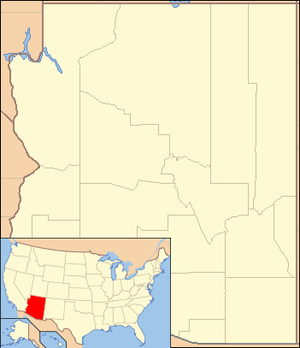
Back منتزه ساغوارو الوطني Arabic Taman Nasional Saguaro BAN Сагуаро (национален парк) Bulgarian Parc Nacional del Saguaro Catalan Saguaro National Park CEB Národní park Saguaro Czech Saguaro National Park Danish Saguaro-Nationalpark German Parque nacional Saguaro Spanish Saguaro rahvuspark ET
| Saguaro National Park | |
|---|---|
 Sunset in the Rincon Mountain District of the park | |
| Location | Tucson, Arizona, Pima, Arizona, United States |
| Coordinates | 32°10′45″N 110°44′13″W / 32.17917°N 110.73694°W |
| Area | 91,716 acres (371.16 km2)[1] |
| Established | March 1, 1933 as a national monument October 14, 1994 as a national park[2] |
| Named for | Saguaro, a cactus |
| Visitors | 908,194 (in 2022)[3] |
| Governing body | National Park Service |
| Website | Saguaro National Park |
Saguaro National Park is a national park of the United States in southeastern Arizona. The 92,000-acre (37,000 ha) park consists of two separate areas—the Tucson Mountain District (TMD), about 10 miles (16 km) west of Tucson, and the Rincon Mountain District (RMD), about 10 miles (16 km) east of the city. Both districts preserve Sonoran Desert landscapes, fauna, and flora, including the giant saguaro cactus.
The volcanic rocks on the surface of the Tucson Mountain District differ greatly from the surface rocks of the Rincon Mountain District; over the past 30 million years, crustal stretching displaced rocks from beneath the Tucson Mountains of the Tucson Mountain District to form the Rincon Mountains of the Rincon Mountain District. Uplifted, domed, and eroded, the Rincon Mountains are significantly higher and wetter than the Tucson Mountains. The Rincons, as one of the Madrean Sky Islands between the southern Rocky Mountains and the Sierra Madre Oriental in Mexico, support high biodiversity and are home to many plants and animals that do not live in the Tucson Mountain District.
Earlier residents of and visitors to the lands in and around the park before its creation included the Hohokam, Sobaipuri, Tohono O'odham, Apaches, Spanish explorers, missionaries, miners, homesteaders, and ranchers. In 1933, President Herbert Hoover used the power of the Antiquities Act to establish the original park, Saguaro National Monument, in the Rincon Mountains. In 1961, President John F. Kennedy added the Tucson Mountain District to the monument and renamed the original tract the Rincon Mountain District. The United States Congress combined the Tucson Mountain District and the Rincon Mountain District to form the national park in 1994.
Popular activities in the park include hiking on its 165 miles (266 km) of trails and sightseeing along paved roads near its two visitor centers. Both districts allow bicycling and horseback riding on selected roads and trails. The Rincon Mountain District offers limited wilderness camping, but there is no overnight camping in the Tucson Mountain District.
- ^ Land Resources Division (December 31, 2016). "National Park Service Listing of Acreage (summary)" (PDF). National Park Service. Retrieved June 11, 2017.
- ^ "S.316 – Saguaro National Park Establishment Act of 1994". Library of Congress. 1994. Retrieved October 13, 2017.
- ^ "NPS Annual Recreation Visits Report". National Park Service. Retrieved October 16, 2023.
